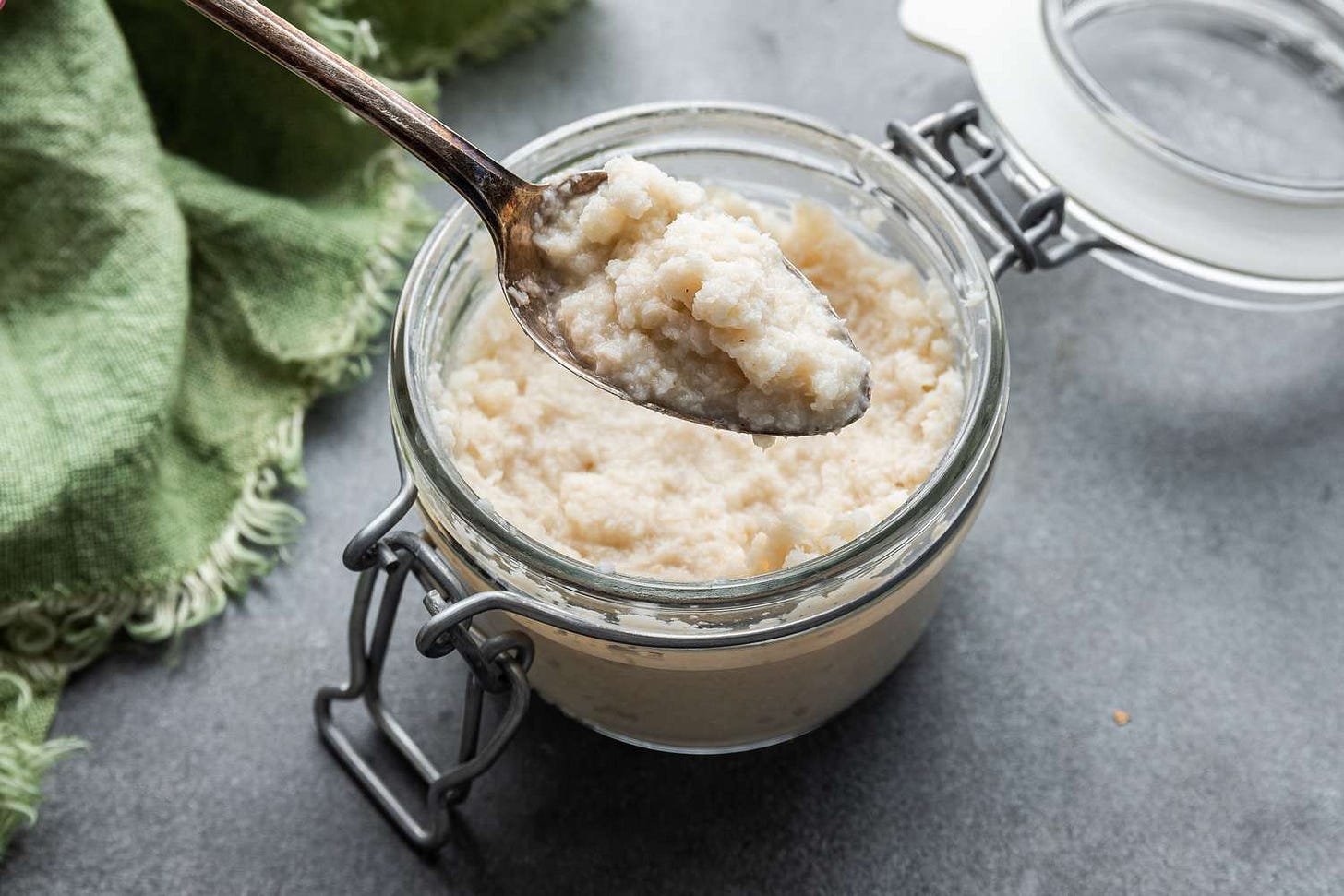Homemade Preserved Horseradish and Horseradish Sauce
A fun condiment to spice up your roasts or gift for the holidays

If you’ve ever had fresh horseradish, you know it’s in a league of its own—bold, spicy, and full of character. Processing your own horseradish root is simple and makes a really fun gift or pantry staple for the holiday season. I use a food processor which makes quick work of pulverizing the root into tiny pieces, but a box grater or microplane works too - especially if you’re making a small amount. It’s a quick process with minimal ingredients to transform this humble root into a vibrant condiment, perfect for roast beef, oysters, cocktail sauce, or Bloody Marys. I often add it to sandwiches for a little zip or stir it into sour cream for horseradish sauce.
Wasabi vs. Horseradish: What’s the Difference?
Wasabi and horseradish might seem like twins separated at birth, but they’re quite different. Horseradish is a root vegetable from the mustard family. It’s the hardy, hairy brown root you see on roast beef plates and taste in cocktail sauce. It brings a bold, in-your-face heat that can be very strong. Sharp and pungent it hits the sinuses hard and dissipates quickly. It’s also very easy to grow.

Wasabi is the more delicate, high-maintenance cousin native to Japan and is cultivated for the rhizome (underground stem) rather than the root. It’s fresh, herbal, and smoother than horseradish, but because its so hard and labor-intensive to grow it’s very expensive. Most “wasabi” you’ve had (the green packets and tubes) is actually a mix of horseradish, mustard, and green food coloring. True wasabi has a much subtler flavor and is almost exclusively served in high-end Japanese restaurants or specialty markets.
Why Homemade?
Store-bought horseradish often loses its potency and brightness quickly, but when you make your own, you control the flavor and freshness. Plus, it’s an easy, thoughtful and fun gift for food lovers. Or someone who doesn’t enjoy sweets.
Ingredients (Yields about 2 cups prepared horseradish):
1-2 large fresh horseradish roots (enough for 1 cup grated horseradish)
about ½ cup white vinegar (adjust to taste)
1 tsp kosher salt (per 2 cups of processed horseradish - or salt to taste)
Instructions:
Scrub the horseradish root thoroughly to remove dirt.
Peel it using a vegetable peeler, as you would a carrot.
Chop into 1-2 inch chunks to make it easier to process (unless you’re grating by hand - then keep the root whole so you can hold it more easily.)
Place the chopped root into a food processor. Pulse until the pieces are finely grated. If you don’t have a food processor, use a box grater or microplane. This is where things get intense! Horseradish releases powerful fumes that can make your eyes water. Open a window or take breaks if needed.
Dump the grated horseradish into a large mixing bowl. For a milder flavor, add the vinegar immediately after grating. For extra heat, let the grated horseradish sit for 10 minutes before adding the vinegar and kosher salt. Add enough vinegar so that the horseradish is completely saturated.
Taste your horseradish and adjust the vinegar or salt to suit your preferences. If you like it slightly sweeter, you can stir in 1 tsp of sugar.
Spoon the mixture into clean, sterilized jars, leaving a bit of space at the top. Seal tightly.
Store in the fridge, where it will keep for up to 6 months.
Gifting Tips
Add a festive touch by tying a ribbon around the jar and including a handwritten label
Serving Ideas
Serve alongside roast beef, prime rib or beef stew
Add to your favorite sandwiches for a little zing
Turn horseradish into a sauce by adding to sour cream (see below).
Add to ketchup to make cocktail sauce for shrimp or oysters. Or add to cocktail sauce you already have to make it spicier!
Mix into scrambled eggs or an omelet for a spicy twist.
Stir into a Bloody Mary for a signature spicy kick.
Horseradish Sauce
1 cup sour cream
2 tablespoons Dijon mustard
2 tablespoons grainy Dijon mustard (optional but I love it for the pops of mustard seed)
8 oz jar of prepared horseradish (or use above recipe)
1/2 teaspoon salt
1/2 teaspoon freshly ground pepper
To get a thick horseradish sauce, I like to drain the vinegar from the horseradish. I dump the horseradish in a mesh strainer and use the back of a spoon or ladle to press on it and squeeze out the vinegar. You can discard the vinegar or save it for a spicy salad dressing. If you want a thin, more runny sauce, you can leave the vinegar in.
Now whisk all ingredients together in a small bowl until well combined.
Like it? If so, I’d love for you to share, like ❤️, and let me know what you think. Your feedback is important and can spark many ideas. Thanks so much





